
Construction of Littledown Miniature Railway
With over 35 years of experience at Kings Park it was decided to continue with a concrete beam and steel rail. Kings Park was built on a rubbish tip and the members cast the concrete beams in situ - taking three years to complete the task. For the Littledown track we were able to employ a contractor to do the hard work for us. Four standard, pre-cast concrete beams each 4m long were used for the entire track - straight, curved with built-in cant and left-hand and right-hand transitions. The beams were cast on a production line basis by a local company to a schedule worked out by the main contractor.
●
The beams are supported at each end in galvanised steel trays, jig-welded onto substantial galvanised steel stanchions concreted into accurately augured holes just over 1m deep. Each beam sits on a hard rubber pad fitted into the steel tray and it is fairly easy to adjust the level of the beams by inserting extra rubber pads. Each beam weighs around 700kg and is held in place by gravity. However, all the curved beams have had special clamps fitted as an extra precaution.
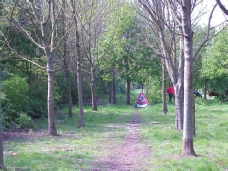
The land slopes rapidly down to the lake and parts of the track ended up over 1.4m above the ground so the Council decided to do some extensive landscaping to bring the ground level up to 150mm below the bottom of the beam.
The curves are standardised at a radius of 17m and super-elevation is built into the concrete beams. This was designed for a balancing speed of around 6mph and is 18mm over the 270mm width of the beam. The transition beams ensure a smooth entry and exit.
Thought had been given early on to the type of track to be used. Kings Park used 3/8 inch square steel bar held onto hardwood sleepers by screws through steel plates jig-welded to the 'rail' - definitely not 'low maintenance' track work. Re-cycled plastic offered a long-life 'fit and forget' alternative to wood - if it would stand up to having hot cinders dropped onto it. Tests were carried out on samples obtained from a Scottish company by playing a flame from a blowlamp onto a sleeper to see what happened. As long as the flame was kept on the plastic sleeper it burned, but very slowly. As soon as the flame was removed any residual fire went out and the plastic solidified. Tests also showed that the material could be sawn using a fast running carbide tipped saw blade and drilled using special fast flute drills, again run fast. The material was obtained in plank form and it took two Sundays in a commercial woodworking shop to saw up the 4,000 sleepers ready to be farmed out to volunteers to have the nine pilot holes accurately drilled using drilling jigs specially made for the job by a member.
The curves are standardised at a radius of 17m and super-elevation is built into the concrete beams. This was designed for a balancing speed of around 6mph and is 18mm over the 270mm width of the beam. The transition beams ensure a smooth entry and exit.
Thought had been given early on to the type of track to be used. Kings Park used 3/8 inch square steel bar held onto hardwood sleepers by screws through steel plates jig-welded to the 'rail' - definitely not 'low maintenance' track work. Re-cycled plastic offered a long-life 'fit and forget' alternative to wood - if it would stand up to having hot cinders dropped onto it. Tests were carried out on samples obtained from a Scottish company by playing a flame from a blowlamp onto a sleeper to see what happened. As long as the flame was kept on the plastic sleeper it burned, but very slowly. As soon as the flame was removed any residual fire went out and the plastic solidified. Tests also showed that the material could be sawn using a fast running carbide tipped saw blade and drilled using special fast flute drills, again run fast. The material was obtained in plank form and it took two Sundays in a commercial woodworking shop to saw up the 4,000 sleepers ready to be farmed out to volunteers to have the nine pilot holes accurately drilled using drilling jigs specially made for the job by a member.
The track made up in panels, each 3m long using 1kg/m steel flat bottom rail. As the railway caters for 3.5, 5 and 7.25 in gauges there are four rails to be laid and this works out at some 2.5 tonnes of rail. The rails are carried on plastic baseplates and fastened to the sleepers by 4.2mm dia. hex-headed, self-tapping screws with large washers. The sleepers are spaced at 150mm centres and every joint is supported for extra strength.
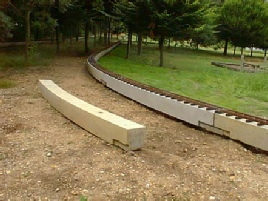
The contractor used by the Council to carry out landscaping work managed to crack one of the curved beams with his large tracked excavator! A replacement beam was cast, at his expense of course, and the broken beam lies alongside the new one awaiting future burial. The construction of the concrete beams and supports can be seen in this picture.
A simple jig was built to make the construction of track panels relatively painless and this allowed two straight panels to be built simultaneously. A production line was established with members carrying out the menial tasks such as putting a washer onto all 32,000 screws! Others then loaded the 4,000 sleepers with screws and baseplates ready to be put into the jig and the rails, which had been cut to length and jig- drilled at each end for the fishplate bolts, slid into place. The screws were than tightened using cordless electric screwdrivers and the completed panel put onto the growing stack in the Engine Shed ready for laying.
The old Kings Park Engine Shed was re-erected at Littledown. The brick extension on the end is the carriage store and essential toilets.
Curved track panels were built in a similar manner, but each of the four lengths of rail had to be accurately cut to length, jig-drilled at each end for the fishplate bolts and then rolled. A member built the rolls, making curving the rail an easy task. The transitions posed other problems and it was found easier to sort these out as the track was laid onto the beam.
Curved track panels were built in a similar manner, but each of the four lengths of rail had to be accurately cut to length, jig-drilled at each end for the fishplate bolts and then rolled. A member built the rolls, making curving the rail an easy task. The transitions posed other problems and it was found easier to sort these out as the track was laid onto the beam.
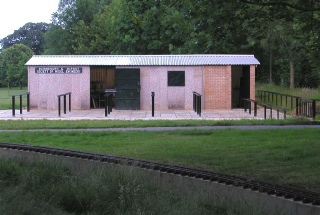
The track panels were fastened onto the concrete beam using stainless wood screws into plastic plugs in holes drilled through the pilot hole in the centre of the sleeper and into the beam - a cheap SDS Plus hammer drill making easy work of this task.
There has to be a means of getting trains on and off of the track and at Kings Park a massive, two-track traverser 20 ft long was the solution. However, it had become more and more difficult for an ageing membership to operate, so various ideas were investigated for the new track. Guildford had installed an ingenious flexible beam and they offered us a set of drawings. A visit was arranged to see the operation at close quarters and the design was modified to take into account our extra rail. The heart of the 'Bendy Beam' is the 2m long flexible section. This is built on two 12mm thick steel plates carrying a series of specially machined steel sleepers that are able to slide in a controlled manner. These sleepers carry four flexible 'rails', each made from four stainless steel strips that are segmented to allow the rails to lengthen or shorten as needed as the beam is curved. These strips were laser cut by a local company from 1.6mm thick 316 stainless steel sheet, this being the easiest way of ensuring that the strips were consistent and had accurately positioned obround slots. The old traverser salvaged from Kings Park was modified to provide the swinging beams and the 'Bendy Beam' was the last part of the main line to be fitted.
There has to be a means of getting trains on and off of the track and at Kings Park a massive, two-track traverser 20 ft long was the solution. However, it had become more and more difficult for an ageing membership to operate, so various ideas were investigated for the new track. Guildford had installed an ingenious flexible beam and they offered us a set of drawings. A visit was arranged to see the operation at close quarters and the design was modified to take into account our extra rail. The heart of the 'Bendy Beam' is the 2m long flexible section. This is built on two 12mm thick steel plates carrying a series of specially machined steel sleepers that are able to slide in a controlled manner. These sleepers carry four flexible 'rails', each made from four stainless steel strips that are segmented to allow the rails to lengthen or shorten as needed as the beam is curved. These strips were laser cut by a local company from 1.6mm thick 316 stainless steel sheet, this being the easiest way of ensuring that the strips were consistent and had accurately positioned obround slots. The old traverser salvaged from Kings Park was modified to provide the swinging beams and the 'Bendy Beam' was the last part of the main line to be fitted.
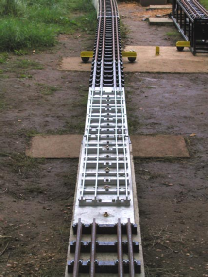
The 'Bendy Beam' set for the main line.
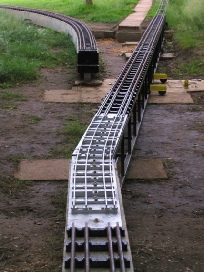
The 'Bendy Beam' in the curved position. The hinged section of the spur road gives the necessary clearance from the main line when in the straight position. Without this feature the rigid part of the 'Bendy Beam' would have to be almost 10m long!
October, November and December turned out to be the wettest on record and a lot of effort was put into stabilising the quagmire that quickly developed all round the Steaming Bay area. Money had to be spent on sorting it out just so that we could move around. The Engine Shed, which had been in the Council store for over a year, was re-erected for us by the contractor. Unfortunately between being dismantled by AFC Bournemouth's contractor and getting into storage the steel roof and heavy steel door had vanished, adding more unbudgeted expense.
The Golden Fishplate ceremony was held 51 weeks after the contractor had started work. Exactly one year to the day we ran the railway for a private Fun Day, carrying an estimated 600 passengers.
After 51 weeks Dick Ganderton installs the 'Golden Fishplate' to complete the track.
The Golden Fishplate ceremony was held 51 weeks after the contractor had started work. Exactly one year to the day we ran the railway for a private Fun Day, carrying an estimated 600 passengers.
After 51 weeks Dick Ganderton installs the 'Golden Fishplate' to complete the track.

